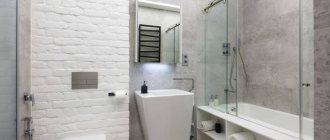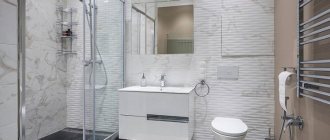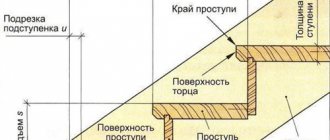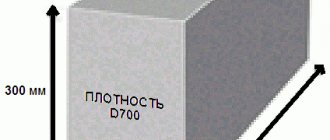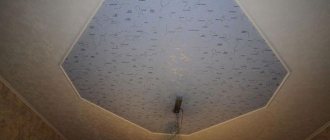When buying a new home, few people pay attention to the size of the bathroom. But this room is one of the most frequently used in an apartment/house. Therefore, it is very important that the bathroom has a sufficient area so that it can accommodate the necessary plumbing fixtures, household appliances, at least a minimum of furniture, and at the same time be comfortable to use.
In this article we will look at the standards by which bathrooms are built, their minimum and typical sizes.
Invalid Displayed Gallery
Minimum sizes of bathrooms
Bathrooms and toilets in apartments of different sizes and houses of different types differ in size and configuration.
Determines the minimum dimensions of a bathroom SNiP (full name “Sanitary Norms and Rules”) for residential premises. The minimum dimensions of a separate toilet, equipped with a toilet and a sink, depend on the method of opening the door in the room. The size of the bathroom and toilet doorway is 75x210 cm, the door width is 60-70 cm.
If, then for convenient use there will be enough space of 0.9x1.15 m. If the door opens into the room, taking away part of its area, then the minimum dimensions of the toilet are 0.9x1.45 m.
Briefly about the main thing
Today, the dimensions of the bathroom in public buildings differ from the dimensions of hygienic rooms in modern private houses. During the development of projects for suburban residential buildings, the necessary values are taken from GOST and SNiP. Although the parameters of sanitary combined and separate premises are standardized, in cottages they can be increased to the required value depending on the dimensions of the house. In this case, the width, depth and height of a typical toilet cannot be less than 800, 1200 and 2500 mm, respectively. The minimum dimensions of a restroom for a disabled person are 1650, 1800 and 2500 mm.
Ratings 0
Standard dimensions of different models
It is worth highlighting the special standard dimensions of a toilet with a cistern, which are generally accepted and optimal, since in the old days almost all of this plumbing equipment was designed according to them. Nowadays, you can even place an order for a special product according to your size, but you need to start from the standard parameters. Such devices are aimed at people with classic characteristics of weight and height. The following standard characteristics can be highlighted:
- with a solid cast shelf on which a flush cistern is installed (compact toilet);
- without a shelf, when the tank is mounted to the wall and built into it.
The state standard (GOST) establishes the following standard size of floor-standing compact toilets with a cistern:
- depth (length) – from 61 to 64.5 cm;
- width – from 34.5 cm;
- height – from 37 to 39.5 cm.
Toilets without a shelf have the following parameters:
- length – from 43.5 to 46 cm;
- width – from 36 cm;
- height – 35.5-40 cm.
Foreign standards are somewhat different from domestic products:
- depth – up to 68.5 cm;
- width – up to 36.5 cm;
- height – up to 41 cm.
Among floor-standing toilets, you can find corner versions, which, due to the features of their design, are also in demand for installation in non-residential and residential premises in order to save space.
The dimensions of the corner toilet directly depend on the dimensions of the corner into which it will be mounted. A corner toilet may have the following dimensions:
- width – from 34.5 to 37.5 cm;
- depth – 72.5-79 cm;
- height – from 37 to 43 cm.
If we consider the parameters of the wall-hung modification of the toilet with installation, then here they differ somewhat from the standard. This model is mounted in such a way that the communication lines are hidden, and the bowl itself does not touch the floor, as a result of which the height of a wall-hung toilet from the floor is calculated completely differently. Manufacturers indicate the height of the bowl, and the owner can decide personally at what distance from the floor to place it.
The advantages of a suspended structure are a visual increase in usable space and a harmonious combination with the interior decoration. In addition, installing such a toilet makes it possible to significantly simplify the procedure for cleaning the toilet, since the drain does not interfere with freely wiping the floor under the bowl.
Suspended modifications can withstand loads of up to 450 kilograms; in other words, despite their elegance and external fragility, they are quite strong and reliable. The parameters of the suspended structure, not taking into account the installation, have the following dimensions:
- width – from 35.5 cm to 37 cm;
- depth – from 48 cm to 70 cm;
- height – from 35 cm to 40 cm.
The dimensions of the built-in equipment of the floor-mounted and wall-hung modifications of the toilet with installation have the following dimensions:
- width – from 35.5 to 37 cm;
- depth – from 47 to 58 cm;
- height – from 39 to 42 cm.
Installing a toilet installation makes the use of a plumbing fixture essentially silent, as conditions are created for high-quality sound insulation when water is drawn into the tank and flushed. A strong fastening guarantees the stability of the entire installation system.
Let's start work
After selecting materials and design, use the detailed repair instructions yourself and begin the repair process. Where should I start? Of course, from dismantling.
Next is the installation of a new sewer system. Today, plastic is used, which is more affordable, much lighter, but not inferior in reliability to conventional materials.
When purchasing plumbing fixtures, it is important to check the availability of rubber gaskets. If there is a shortage of them, unwanted problems associated with the strength of connections may appear.
Then the wiring and pipes are changed
Today, risers are made from polypropylene, which is important to attach to the wall surface as firmly as possible to prevent deformation.
When creating electrical wiring, it is important not to forget that it must be hidden in the corrugation, while it is preferable to place the connections of the required wires outside the room. Another important point is the ventilation system. It’s often clogged, so it wouldn’t hurt to clean it and hide it under the grate
It is often clogged, so it would not be superfluous to clean it and hide it under the grate.
The final stage is the installation of the toilet, as well as the assembly of the cabinet for plumbing.
Norms
The bathroom plays an important role in creating a comfortable and functional home. It largely depends on its size:
- how you will place all the main plumbing structures (bathtub, shower stall, as well as sink, washbasin and bidet);
- how utilities will be laid;
- what types of finishes can be used.
The minimum permissible area of toilets, as well as other parameters related to the dimensions of these premises, are legally regulated through GOSTs and SNiPs - they establish the footage of bathtubs and toilets in residential apartments, as well as acceptable parameters for public buildings for various purposes.
When starting redevelopment work in your home, you should carefully study the entire legal framework in this area. Otherwise, you risk that the result of your work may be recognized as not meeting current standards, illegal and subject to dismantling.
Please note: for Belarus, as well as Ukraine and a number of other CIS countries, SNiP standards regarding the footage of bathrooms may differ significantly from those approved in our country. Standards for some regions of the Russian Federation may have their own differences. A certain group of restrictions also applies to the placement of sanitary rooms in apartment buildings
Thus, you may be refused approval for redevelopment if you intend to place a restroom above the kitchen or above the living area; the only exception may be 2-level apartments with large footage
A certain group of restrictions also concerns the specific placement of sanitary rooms in apartment buildings. Thus, you may be refused approval for redevelopment if you intend to place a restroom above the kitchen or above the living area; the only exception may be 2-level apartments with large footage.
The only option when the construction and redevelopment of a toilet can be carried out without taking into account the standard is to carry out work in a cottage, private house or country house. If you are not going to connect intra-house communications to a common sewer riser and a central water supply system, then there are no requirements for strict adherence to current standards.
Let's figure out what the optimal size of a sanitary room is. Dimensions of the hygienic room in the apartment:
- depth - not less than 1.2 m;
- width - not less than 0.8 m;
- ceiling height - not lower than 2.5 m;
- distance from the toilet bowl to the inclined plane of the roof (for toilets located in the attic) - 1.05-1.1 m;
- The ceiling height in the hallway near the entrance to the restroom is not lower than 2.1 m.
Additionally, recommendations were made regarding the placement of plumbing fixtures and the distances between individual elements of the bathroom:
- between the toilet bowl and the bidet - from 25 cm;
- in front of the bath bowl - from 70 cm of unoccupied space;
- near the toilet - from 60 cm;
- on both sides of the toilet - from 25 cm;
- in front of the sink - from 70 cm.
The exit from the toilet should lead either to the hallway or to the corridor - it is not recommended to place it near the kitchen, dining room or living rooms.
Bathrooms installed for users with disabilities are subject to separate regulation. In accordance with accepted standards for people with disabilities, the parameters of the restroom should have the following dimensions:
- width -1.65 m;
- depth - 1.8 m.
According to the law, the installation of additional plumbing equipment (bidets and urinals) is optional, but their installation is desirable. In addition, it is necessary to select the optimal location of the plumbing fixtures, so that a user in a wheelchair can easily get there without outside help.
It is mandatory to install handrails near the toilet and washbasin; the optimal height for their placement is 75 cm.
It is desirable that on the side where a person transfers from the chair to the toilet, the latter should be folding.
What can it be like in a private house?
A bathroom installed in a cottage or small private house has no restrictions; its dimensions depend only on the personal preferences of the owner, as well as on the technical capabilities of the room as a whole.
However, this only applies to situations where the restroom is located inside the house
If you are installing an outdoor toilet, then you will have to pay special attention to the choice of location, since in this case certain standards and requirements also apply
SNiP establishes the following rules for choosing the location of the drainage pit:
- the closet must be located at least 10-12 m from any residential building;
- the area where sewage accumulates must be no less than 25 m away from a drinking well or stationary water source;
- the toilet area should be 1 m or more from the boundary fence;
- an outdoor bathroom should be located at least 12-13 m relative to the utility room, cellar and basement;
- There should be at least 4 m to the nearest fruit trees.
In order to correctly determine the parameters of outdoor toilets, you first need to think about the type of construction of such a bathroom. The most commonly used option is for a village toilet, which involves a drainage pit. In more modern houses, a backlash closet is designed; it involves installing a septic tank with reliable waterproofing; this design prevents clogging of groundwater and soil.
Standard and minimum dimensions of a bathroom, choosing the optimal size
When buying a new home, few people pay attention to the size of the bathroom. But this room is one of the most frequently used in an apartment/house
Therefore, it is very important that the bathroom has a sufficient area so that it can accommodate the necessary plumbing fixtures, household appliances, at least a minimum of furniture, and at the same time be comfortable to use
Therefore, it is very important that the bathroom has a sufficient area so that it can accommodate the necessary plumbing fixtures, household appliances, at least a minimum of furniture, and at the same time be comfortable to use. https://www.youtube.com/embed/CBWQbwy4FjU. https://www.youtube.com/embed/CBWQbwy4FjU
In this article we will look at the standards by which bathrooms are built, their minimum and typical sizes.
How to choose the right size for your future bathroom, optimal dimensions
In order for the bathroom to be functional and easy to use for each family member, you should know the optimal sizes of bathrooms in residential buildings:
- room width - at least 80 cm;
- height - about 250 cm;
- depth - minimum 120 cm.
By taking the dimensions of the combined bathroom, you can rationally use its area when arranging plumbing fixtures. An approach of at least 60 cm should be provided to the toilet and 25 cm to the left and right of it. For access to the sink, leave 70 cm, a comfortable height for its location is 80-90 cm. Free access to the bathtub or shower is 70-120 cm.
Note: according to an unspoken rule, frequently used items in the bathroom should be within arm's reach.
Plumbing installation rules
The dimensions of a bathroom in a private house, as a rule, are not as limited as in a city apartment, so they can accommodate any plumbing fixtures. But for small bathrooms in multi-story buildings, it is better to choose compact models.
Typical bathroom sizes
Let's consider room layout options for standard bathroom sizes.
Small rooms of 2x2 m, as well as 1.5x2 m, are the minimum area that a person needs. If the bathroom and toilet are separate, it makes sense to combine them and expand the usable space.
Note: this type of redevelopment, which does not involve moving pipes, is approved according to a simplified scheme.
Examples of layouts for mini-bathrooms with an area of 2 square meters. meters and 3 m2
Bathroom area from 4 sq. m. up to 6 sq. m. already has enough space to be equipped with a washing machine and a small cabinet for things. Depending on the location of the door, plumbing fixtures can be placed either around the perimeter of the room or on opposite sides.
Layout of medium-sized bathrooms in a panel house
In a room of 7 sq. m. fit the necessary plumbing and household appliances. If there are many people living in the apartment, you can install two sinks, or a second bathing tank.
Tip: it is advisable to divide a large bathroom into functional areas.
Options for bathroom layout 7 sq. m.
If the bathroom is narrow and long, then the bathing tank is installed in the very depths of the room. It is better to install the toilet, sink and bidet along the walls in the order in which they are most often used.
Ways to plan a narrow bathroom
Minimum sizes of bathrooms
Bathrooms and toilets in apartments of different sizes and houses of different types differ in size and configuration. Determines the minimum dimensions of a bathroom SNiP (full name “Sanitary Norms and Rules”) for residential premises.
The minimum dimensions of a separate toilet, equipped with a toilet and a sink, depend on the method of opening the door in the room. The size of the bathroom and toilet doorway is 75x210 cm, the door width is 60-70 cm.
If the door opens outward, then a space of 0.9x1.15 m will be sufficient for convenient use. If the door opens into the room, taking away part of its area, then the minimum dimensions of the toilet are 0.9x1.45 m.
Minimum toilet dimensions
Minimum dimensions of a shared bathroom with shower
If the hygienic room is equipped with a tank-bathtub, the minimum width of the bathroom, depending on the location of the plumbing, will already be 2.1x2.1 m, or 2.35x1.7 m (2.35x2.5 m).
Minimum dimensions of a bathroom with a tank-bath
Important: when constructing new buildings, the minimum dimensions of the bathroom, regulated by SNiP, must be taken as a basis.
Bottom line
The dimensions of the bathroom are of great importance, especially if a large family lives in the house/apartment. Knowing the minimum dimensions of a bathroom and how to organize space, you can make even a small bathroom comfortable.
Video description
The following video will help you create a thoughtful sanitary facility:
On a note! Experts note that many homeowners strive to maximize the area of the sanitary room. They definitely think about this if there are no external restrictions on the dimensions of such a room. After all, they won’t have to save every meter or even centimeter of usable space. However, this decision is not always the right one, because a large toilet is a waste of useful space at home. It can be used more rationally. For example, to increase the area of the living room or dining room, where there is a place for every family member.
The best option for a private home is the rational use of every meter of sanitary facilities Source mykaleidoscope.ru
Compact
Many bathrooms that have a relatively small area are usually equipped with plumbing systems called compacts. This approach has long been a common solution, since these products are characterized by versatility and can significantly save space. The main design feature is that the tank is attached directly to the bowl, which in itself greatly simplifies installation.
The compacts currently on the market come with a built-in or separate shelf. It is also necessary to take into account that, according to the legislation in force in the Russian Federation, the dimensions of manufactured plumbing fixtures are regulated by the relevant GOSTs. As a result, the parameters of the considered designs of imported and domestic production may differ significantly from each other.
The standard dimensions of a compact with a built-in shelf are:
- length – 34 cm;
- width – 37 cm;
- height – up to 61 cm.
conclusions
The minimum size of a bathroom in an apartment and a private house is not a death sentence. With the right approach and layout, your bathroom will become a cozy place.
At first glance, the calculation may seem like a difficult task, because it is important to take into account not only your aesthetic taste, but also all the features of the premises. But when you know how to calculate the area, what are the recommendations for placing plumbing fixtures, you can have your own personal plumbing masterpiece
It is important to remember that the area of your bathroom must be suitable to comply with the above standards. Otherwise, you will be very uncomfortable using the plumbing and the room itself.
Why the bathroom should be ergonomic
The toilet is one of the most in-demand rooms in any home. The use of various plumbing fixtures should be safe and practical, and the overall decor of the toilet room should be pleasing to the eye. If all the rules for arranging plumbing fixtures are followed and the repairs are carried out in accordance with the standards, then using the bathroom will be comfortable and convenient.
In the process of renovating a bathroom, in order for the resulting room to be functional and comfortable, it is necessary to follow certain rules that determine the minimum dimensions of plumbing fixtures and the distances between individual pieces of equipment. The space in this room will be organized in such a way that all planned devices will fit in it, in addition, you will be able to use them freely and comfortably. The main and irreplaceable devices, of course, are the toilet and sink. You must plan the placement of furniture and shelves correctly. Often in this room it is also necessary to find a place for a washing machine.
If you have already decided which pieces of furniture, fixtures and equipment will be placed in the bathroom, you can start planning their location, taking into account the correct distances. Before you begin planning the interior design of a bathroom, you need to know the distance from the toilet to the wall, the standards that are established in order to comply with sanitary and hygienic requirements, as well as to ensure convenience when using plumbing fixtures.
Useful tips
To make the bathroom cozy and comfortable, you need to draw up a competent design project: not only correctly and rationally place furniture, plumbing fixtures and other appliances, but also choose a color scheme, organize lighting, etc.
Choice of colors
To choose the right color scheme for the bathroom, you need to consider the following factors:
- Number of tones. To create a stylish and harmonious design in the bathroom, you should not use more than 3 colors or 5 shades at the same time. It is often possible to create a stylish design using 2 colors; they can be either compatible or contrasting. You can use 2-3 tones of the same color.
- Brightness. Here it is necessary to take into account the size of the room. Dark colors visually reduce space, so they should be used carefully in small rooms. Bright and juicy shades help you cheer up in the morning, and calm ones help you relax while taking water treatments.
- Color. Each color has a certain mental effect on a person. Warm tones soothe and relax, cool tones invigorate. A lot of white is hard on the eyes; it is better to combine it with other colors. Dark colors not only visually reduce space, but also have a depressing effect. The best colors for the bathroom are blue, sand, light green, and peach.
Construction of lighting
When creating lighting in the bathroom, you must follow safety rules. If the room is small, then installing sockets and switches in it is not allowed. If the bathroom area is more than 8-10 m², then the socket is placed no closer than 60 cm to the toilet, bathtub, washbasin or bidet. Equipment with a degree of protection of IP 44 is suitable for these purposes. Only hidden wiring is allowed; grounding is required. The lamps used must be designed to operate in conditions of high humidity.
Using 2 in 1 furniture
The level of comfort is constantly increasing, and now it is difficult to imagine a sanitary facility without a bidet or a hygienic shower. Due to the small size of bathrooms and combined bathrooms, it is recommended to use modern models of plumbing fixtures, for example, a bidet toilet, to save space. Under the sink you can make a cabinet with shelves, which will simultaneously hide the washing machine and store hygiene products.
Dimensions of a combined toilet and bath
The footage of a combined restroom, in accordance with accepted standards, must provide for the possibility of installing a bathtub or shower with a tray, as well as installing a washbasin and toilet in compliance with the recommended distances between the individual elements of the room specified in SNiPs.
It should be noted that combined sanitary facilities are not for panel buildings. The reason for this is that in such buildings, plumbing cubicles are used to equip the bathroom - these are ready-made blocks assembled in production, which are simply built into the structure of the residential building. In accordance with the adopted layout, the sanitary cabin is a separate bathroom with space for a toilet, as well as an area for a washing room; the compartments are separated from each other by a solid partition. The dimensions of cabins in panel construction are standardized, the location of the washbasin and bathtub in them corresponds to existing standards.
Standard toilet sizes and minimum toilet size
GOST 30493-96 standardizes the dimensions of toilets with a shelf only. There are also those that are installed in cars, but we don’t need them. The standard dimensions of a toilet with a shelf are prescribed for two options: with a solid cast and with an attached one. The second model is used in conjunction with mounted/wall-mounted tanks or without them at all. There are also standard sizes for children's toilets. They (children's) come without a shelf. All sizes are shown in the table. And to understand what we are talking about, look at the drawings.
Drawing of a toilet with a solid cast shelf and an oblique outlet from GOST
| Toilet design | H | h | h1 | l | l1 | L (depth or length) | b | B (width at widest point) |
| With a one-piece shelf for installing a tank (Compact) | 150 | 330 | 435 | no less than 605 (maybe 575 mm) | 260 | 340 and 360 | ||
| Without shelf (mounted tank) | 370 and 400 | 320 and 350 | 460 | |||||
| Children's | 335 | 285 | 130 | 280 | 380 | 405 | 210 | 290 |
So, the standard size of a toilet with a shelf (usually called “Compact”):
- Length - L - 605 mm. This is taking into account the fact that the model is compact with a protrusion for installing a tank. It is separately stated that shorter models with a length of up to 575 mm can be produced.
- Width - B - also two standard values: 340 and 360 mm.
The height of toilets is not standardized, but usually within the range of 370-390 mm. So, according to the standard, the narrowest toilet is 340 mm, and the shortest model “compact with shelf and oblique flush” is 575 mm. Based on these values and the minimum permissible distances from the previous paragraph, we can determine the minimum dimensions of the toilet for installing such a model. Let's start by calculating the width: 340 mm + 2 * 250 mm = 840 mm. That is, the distance between the walls cannot be less than 84 cm. Better, of course, more.
And the length of the toilet should be 575 mm + 600 mm = 1175 mm. But this does not take into account the fact that it is also necessary to lay a sewer pipe and somehow connect the drain. We will allocate another 20 cm for this. In total, we find that the minimum length of the toilet room is 1175 mm + 200 mm = 1375 mm. In meters it is 1.375 m.
Standard dimensions of a toilet without a shelf (with a hanging cistern) from GOST
The standard dimensions of a toilet with a wall-mounted cistern are significantly smaller: length/depth 460 mm, width 360 mm and 340 mm. That is, the room may be shorter. Its minimum depth is 1060 mm - this is only for a comfortable installation of the bowl, but you still need to connect the pipes, so we’ll add another 20 cm. In total, we get that to install a toilet with a wall-mounted cistern, the room must be at least 126 * 84 cm. A if you have a longer room, you can move the miracle of plumbing back, and make a cabinet with shelves behind the toilet and/or above it.
Project for a very small bathroom - area 2.7 sq.m.
Bathroom width 1.6 m length 1.7 m
Pay attention to the compact location of the plumber and the small central passage measures only 60x80cm
The shower niche is quite wide in size (80x160cm) and has two front walls made of gypsum boards that perform the function of zoning the room.
85cm double-leaf swing doors made of 5mm tempered glass. For such a width it became possible to make a seat, which is also very comfortable.
Drain system in the floor, through a long drain tray. The shower system is multifunctional.
A 65cm overhead furniture sink together with shelves and a mirror performs the function of furniture. A wall-hung toilet with an installation system built into the wall.
How to choose?
There is no strictly defined standard for the dimensions of installation frames. In each specific case, the choice is made taking into account the dimensions and design features of the toilet room. If you have enough free space, you can think about installing larger structures, including even a bidet.
If there is a solid wall in the room, it is worth considering block models of installation frames. It is often necessary to equip a non-standard room in limited space. In such cases, experts recommend studying the dimensions of corner structures.
It turns out that choosing a box for subsequent installation of plumbing must take into account not only personal preferences. In this case, we are also talking about the installation and connection features of all products. So, for example, the installation dimensions for a built-in toilet are selected taking into account the distance from the bowl to the wall or pieces of furniture. This value must be at least 60 cm, otherwise using the toilet will be uncomfortable, since your feet will rest against the mentioned obstacles.
Standard systems are suitable for equipping larger rooms. In such cases, the bowl is installed 18-20 cm from the box. And it is recommended to maintain the distance mentioned above on all sides of the plumbing fixture.
Before purchasing and starting installation, you should carefully study the plan of the toilet or bathroom. This will allow you to choose the most convenient and most suitable place for the plumbing and its dimensions
It is worth paying special attention to the following points
- With standard installation of the frame near the walls of the toilet room, you can choose both block and frame models. Their sizes are selected taking into account the dimensions of the plumbing and the room.
- If you need to install a plumbing system in a small room, in the attic or under a window, then you should consider small-sized models. Their height should not exceed 85 cm.
- For installation of plumbing fixtures on both sides of the duct, installations with appropriate fasteners (double-sided) and dimensions are provided.
- When equipping premises in which it is necessary to install several wall-hung toilets at once, special installations are chosen. We are talking about linear structures with a height of 115 cm.
The vast majority of frames are rectangular in shape. At the same time, they should be selected taking into account the commensurability of the parameters of the product itself and the niche. In cases where the box is larger, the voids are usually filled with materials that have soundproofing properties.
The standard dimensions of built-in toilet models are as follows:
- height – from 35 to 45 cm;
- depth – from 50 to 60 cm;
- width – from 30 to 40 cm.
Although the parameters given are standard, they may vary.
It should be remembered that now manufacturing companies offer more than a wide range of models. We can talk about special children's toilets, as well as products with enlarged bowls. In addition, plumbing fixtures are produced for people with disabilities and heavy weight. Naturally, all these factors will determine the choice of installation structures and their dimensions.
In addition to all of the above, you should take into account the size of the cistern. In the vast majority of cases, the thickness of suspended plastic devices is 9.5 cm, and their width is 0.5 m. The height of such tanks, as a rule, is slightly greater than the similar parameters of conventional models
This size varies from 55 to 60 cm
The height of such tanks, as a rule, is slightly higher than the similar parameters of conventional models. This size varies from 55 to 60 cm.
When choosing a frame for installing built-in plumbing, you need to remember the design features of various types of systems. Thus, frame options have a depth of 15-30 cm (more often we are talking about the minimum parameter). The height of such models can be from 85 to 140 cm, and their maximum width is 60 cm.
The following dimensions must also be taken into account:
- the center of the sewer pipe is located 22 cm from the level of the floor covering;
- The distance between mounting holes is 18 to 23 cm.
The minimum dimensions of block installations are, as a rule, identical to the similar parameters of frame structures. Their depth can be from 10 to 15 cm, and their height can be up to 1 meter. It is also necessary to consider the possibility of separate installation of the built-in cistern and toilet bowl. The latter in such cases is not attached to a niche, but directly to the wall.
For more information about the installation for the toilet, see the video below.
Tips for planning
When calculating the size of your bathroom, you need to take into account the dimensions of the plumbing fixtures that you plan to install. With correct calculation, even a room of 2.5 square meters. m. can become comfortable, convenient and beautiful. Many years of experience show that with a competent approach, this space is quite enough to accommodate everything you need.
What else, besides the dimensions of the plumbing, should be taken into account when planning?
For more convenient use of plumbing fixtures, you need to leave free space in front of them and on the sides:
- it is better to leave free space within 100-110 cm, or at least 70 cm, from the shower stall (bathtub);
- at least 60 cm of space in front of the toilet (bidet), on the sides - 25 cm. If both a toilet and a bidet are used, then the required distance between them is 25 cm;
- We leave at least 70 cm of free space in front of the washbasin, and if the washbasin is located in a niche, then the entire 90 cm.
- the distance from the shower or font to other types of plumbing fixtures is at least 70 cm;
- the doorway must be at least 55 cm.
Kinds
In the modern market, a wide range of similar products is offered to the buyer. The types of installations that are used when installing a wall-hung toilet can be divided into 2 main types: frame and block. Let's consider the nuances of each.
Block
To mount this type, you need to make sure that a solid wall will be used for its installation.
This design is characterized by:
- a kind of reinforced flat plastic tank;
- fasteners;
This installation is built entirely inside the wall. It is best to have a ready-made niche in the wall. The main reasons for installing a block installation are its free access and its relatively low price. The main disadvantage is the use of a solid wall for installation. In the absence of a main wall, it is not recommended to use the block type.
Current standards
An important task when planning a house is determining the dimensions of the restroom. Experts are well aware of this, because a correctly calculated bathroom area allows you to create an ergonomic space
In this case, it will be possible to place all the necessary sanitaryware and even furniture with household appliances in the room. Therefore, the overall level of comfort of the entire home depends on the correct determination of the height, depth and width of the toilet in the form of a separate room or combined with a bathroom.
Knowing the dimensions of the sanitary unit, you will be able to understand:
- how the engineering systems will be installed;
- what finishing can be used in the room where sanitary and hygienic procedures are carried out;
- where is the best place to install sanitary products, including a bathtub, washbasin, toilet, shower and even a bidet.
There are current GOSTs and SNiPs, from which it is easy to find out what the minimum width of a toilet is and how much its other parameters are. Designers are guided by this information.
The smallest dimensions of a combined sanitary unit with a full set of plumbing fixtures
If necessary, current standards may not be observed if a restroom is being built or remodeled in a cottage or country house. However, they are still used as a starting point when designing rooms for daily hygiene and sanitary procedures. These parameters have the following meanings:
- minimum width 800 mm;
- minimum depth 1200 mm;
- the minimum height is 2500 mm;
- the shortest distance from the roof slope to the toilet bowl can vary from 1005 mm to 1100 mm when the sanitary room is located on the attic floor;
- the height of the room next to the toilet door must be at least 2100 mm.
The standards also indicate the distance between the equipment and give recommendations regarding the free space next to it:
- in front of the tank-tank - at least 700 mm;
- between the bidet and the toilet bowl - at least 250 mm;
- on the right and left sides of the toilet - at least 250 mm;
- in front of the toilet bowl - no less than 600 mm;
- near the washstand
Standards regarding free space and distances between equipment
In modern cottages, a small sink is almost always installed in the toilet, the dimensions of which exceed the standard values. Although the standard and smallest dimensions of restrooms are still taken as a guideline.
Standardized parameters
Previously, sanitary and hygienic premises had extremely small footage. For example, the area of even a combined sanitary unit was a maximum of 3.8 m2. Nowadays, modern houses are being built with more spacious bathrooms. So, even in small buildings, about 4-6 m2 are allocated for a sanitary room.
If we consider large cottages, then you will rarely find a hygienic room in them with a footage of less than 9 m2. This area is sufficient to accommodate basic plumbing fixtures. Therefore, it is possible to create a high level of comfort during daily hygiene procedures.
Standard restroom parameters
In large hygienic rooms, not only plumbing fixtures are installed, but also furniture modules. Items are used to store household chemicals, cosmetics, and small items. If there is free space, an ironing board is often placed. Therefore, a modern large toilet with standard dimensions, after thoughtful equipment, becomes a functional room. All residents will be able to carry out hygiene procedures as conveniently as possible here.
When organizing bathrooms in new private houses, the following rules are usually followed:
- in small buildings, the parameters of the hygienic room are selected in such a way that a toilet, washbasin and bathtub can be installed in one room;
- in large buildings, the toilet room is separated from the bathroom.
Minimum parameters of bathrooms
The current standards for toilets differ from the sizes of sanitary facilities that were created in old private buildings. In such buildings, the area of hygienic rooms is a maximum of 2 m2. Despite the small footage, even in these premises today.
Small toilet in a private house
For example, the small width of the toilet in a separate bathroom does not become an obstacle to installing a washbasin. To allocate space for it, a toilet installation is installed in the corner. If you also choose a small corner sink, then you will be able to additionally install a compact cabinet in the restroom. This method of installing equipment is especially relevant for sanitary units 1*1 m. When the restroom has dimensions of 1*1.5 m, then the toilet will no longer interfere with the installation of the washstand. It is usually located near the door.
Placing a washing machine above the toilet - compact
Video description
The following video will help you organize the ideal space in a modern combined bathroom:
To create an ergonomic layout in the toilet room, you need to know both the size of the bathroom according to the standards and the standardized dimensions of the following manufactured plumbing equipment:
- the height of a typical tank bath is from 480 mm to 510 mm without legs and 640 mm with supports;
- width and length of a rectangular standard bath – 780-800*1600 mm or 780-800*1700 mm;
- dimensions of corner tank tanks – 1500*1500 mm or 1600*1600 mm;
- parameters of shower cabins – 800*800 mm, 900*900 mm or 1000*1000 mm;
- horizontal dimensions of the bidet – 370*540 mm or 400*600 mm;
- the minimum width of the washbasin is about 400 mm;
- Typical dimensions of a compact toilet are 440*650 mm, 400*600 mm and 360*650 mm.
Selecting furniture and plumbing equipment
Finishing the walls in the same color as the plumbing will make the plumbing fixtures in a small toilet less noticeable: in this case, the bathroom will seem more spacious.
Communications spoil the overall design picture, and to avoid this, disguise them. For example, make small doors that can be opened in case you need access to the pipes for repairs.
Think over this point in advance - before starting repairs, discuss the possibilities of camouflage with a specialist.
One of the best ways to disguise communications is to cover them with plasterboard. Drywall makes it possible to make counters and other structures invisible. In addition, it takes little time to install the slabs; the work will not be difficult to complete.
Many bathrooms have a rug on the floor, but few people know that this design element has the ability to visually reduce the size of the room. But if you remove the rug, your feet will freeze, because the tiles on the floor are cold. The “warm floor” system will solve the problem. Thanks to the “warm floor” you will feel much more comfortable in the toilet room.
If you don’t want to give up the rug, lay a plain product without patterns that matches the tone of the floor covering.
It is also possible to visually expand the boundaries of the room through the use of chrome-plated elements:
- if there is a sink, a tap for it;
- toilet paper holder;
- lever on the toilet cistern;
- door handles.
It is preferable that all fittings be made in the same style.
If you choose the right components, you can turn a small bathroom into a stylish toilet room that will look more spacious than it actually is.
But it also happens that the size of the bathroom is too large. In such a situation, you should select functional pieces of furniture for the room for water treatments. Manufacturers offer furniture designed specifically for bathrooms: tall cabinets for cleaning products and hygiene items, shelves.
On a note! Choose furniture at your discretion, but do not forget that it must fit into the overall concept.
The final touch in creating a bathroom interior is the selection of accessories. Choose a beautiful soap dish, paper dispensers, and heated towel rails for the toilet room.
Non-standard premises
Layout of a bathroom in a non-standard room is an interesting, but painstaking job. Therefore, if you have a non-standard room in your apartment, it is better to involve specialists in its arrangement. If you want to expand the room, then without taking into account all the components you can cause trouble. To the point where the wall may collapse.
But if you have a very large private house, then you will have room to roam. Therefore, in the modern world, non-standard bathrooms are becoming more and more common. When it comes to the interior arrangement of such a room, the owners can afford to fulfill any ideas. In addition to the standard set of plumbing fixtures, they can accommodate additional electronics and furniture. Such rooms can be either square or rectangular. There are also original forms of rooms.
But with smaller rooms you will have to tinker. First you need to draw up a project, which should include the following points:
- linking the doorway to the size of the room;
- connection points for plumbing fixtures and the height of the connections;
- installation points for toilets, bathtubs, cabinets;
- power supply points.
In small non-standard rooms measuring 1.8 m, it is better to replace the bathtub with a shower stall, move the washing machine into the corridor, install a corner sink, above which hang a mirror cabinet. The space will be significantly expanded by a suspended ceiling with a mirror effect and white tiled walls.
To make such a room seem larger visually, combine painting the walls with partial tiling. If you decorate the room entirely with tiles, then you need it to be the same size. It is advisable to lay it out diagonally.
In a room larger than 2.5 m, it is better to remove the partition between the toilet and the bathtub, as it takes up a lot of space. But the room is 4 square meters. m is more comfortable. Here, to save space, it is better to install the bathtub in the far corner and cover the space around it with moisture-proof material.
A bathroom measuring 7 square meters is considered spacious. m. In this option, you can install two sinks, a bidet and a toilet at once.
